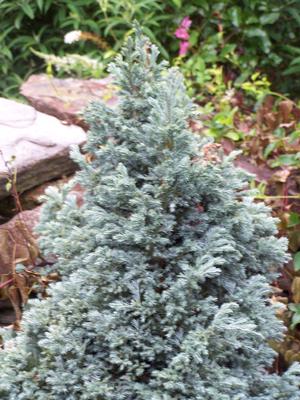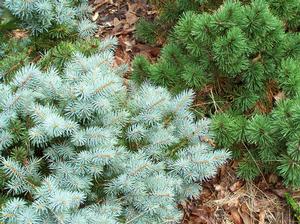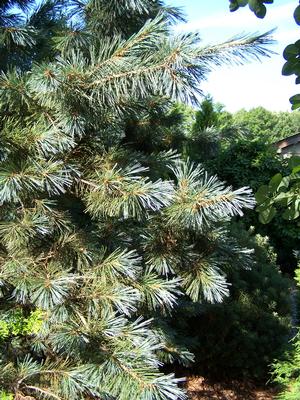
Chamaecyparis pisifera 'Baby Blue' - a fuzzy pic but you get the idea

Picea pungens 'St. Mary's Broom' (left); Pinus mugo 'Valley Cushion' (right)

Pinus flexilis 'Cesarini Blue'
Blue Conifers for a Blue Planet
Watercolor the world! Dab in dense atmospheres of ink blue lakes and indigo rivers, cobalt oceans and robin egg seas. Dip a brush in powder blue and paint the vault of the skies. Magnificent sapphire conifers like glorious water spouts connect the two: giant ever-blue pillars holding the waters and the skies apart.
The essence of this dream portrait can be yours. You can paint your property and hold up the skies of your world with spirals and columns of cool blue conifers. They connect and add chromatic dimension to silvers and grays in the garden. They add depth to greens and contrast with golds. Variegated foliage sparkles anew against a blue backdrop. Red-purple shrubs are a knockout paired with blue conifers. In winter a single large blue conifer backed with the grays and browns of deciduous trees will excite the eye in a way that a green one will not.
We think of water as an element in the garden. So should we consider the skies. Just before dawn and at dusk bright blue evergreens quietly light up against passing lead-purple clouds. Blue conifers fashion a landscape into a Rococo room for a few moments at sunrise and sunset when clouds turn pink and the verge of others glisten with gold.
Blue conifers occurring in all sizes and shapes can fill any number of niches in your garden. From tiny domes to huge pyramids they will artfully augment your planting schemes with aristocratic distinction. Just for you I’d like to paint some portraits of a few of the blue conifers available. Sit back and enjoy these pictures on exhibition…
Abies concolor ‘Compacta’ – White Fir (syn. Concolor Fir). This beautiful White Fir shows off blue needles on a squat upright pyramid. The beautiful silvery blue needles on this dwarf shrub are proportionally smaller than those of its larger brother. Plant one as an anchor with an embroidery of Vaccinium angustifolia ‘Burgundy’ (Lowbush Blueberry) and Helictotrichon sempervirens ‘Sapphire’ (Blue Oat Grass).
Classification*: Dwarf
Height x Width: Might be a little more than 3 feet tall by 3 feet wide at maturity.
Light: Full Sun
Soil: Prefers deep, moist soils with sand/gravel mixed in but is drought tolerant once established
Zone: 4 to 7
Application: Large Rock Garden, Foundation, Heath and Heather Border, Conifer Collection, Perennial Garden, Shrub Border
Chamaecyparis pisifera ‘Baby Blue’ – Sawara Cypress. The blue curls of foliage are half the length of its better known bigger brother, Boulevard Cypress. The tightness gives an overall finer texture to this upright cone. A striking foundation combination would be had with Rhododendron ‘Olga Mezitt’, Hydrangea quercifolia ‘Sike’s Dwarf’ (Dwarf Oakleaf Hydrangea), dwarf white daffodils and a ground cover of Ajuga ‘Black Scallop’.
Classification*: Dwarf
Height x Width: Approximately 4 to 5 feet tall x 2 to 2 ½ feet wide in 10 years
Light: Full Sun
Soil: Moisture retaining fertile soils
Zone: 4 to 8
Application: Foundation, Heath and Heather Border, Conifer Collection, Perennial Garden, Shrub Border
Chamaecyparis thyoides ‘Glauca Pendula’ – White Cedar. Each foliar fan is a lovely light blue. C. t. ‘Glauca Pendula’ is irregular in youth but will develop into a graceful, compact upright pyramid in time. Thicker and happier in more sun it will develop into a looser more open specimen in half shade. This species hails from cedar swamps in the northeast that are sadly becoming rare. Though swamp land is their native haunt any good moisture retentive soil on the acid side will keep them happy. In part shade plant one behind Halesia tetraptera (syn. carolina) ‘UConn Wedding Bells’ (Carolina Silverbell). Foreplant both with Acer palmatum ‘Waterfall’ (a semi-weeping Japanese Maple). Underplant all with a collection of native woodland gems.
Classification*: Large
Height x Width: 40 feet or more high x 10 to 20 feet wide at maturity
Light: Full Sun for a tighter specimen, part shade for a looser, shaggier plant
Soil: Moisture retaining fertile soils
Zone: 4 to 8(9)
Application: Conifer Collection, Mixed Hedgerow, Large Shrub Border, Screen
Cunninghamia lanceolata 'Ohio Form' – Common Chinafir. This powdery blue form of Common Chinafir likely embodies greater hardiness than its green counterpart. Stiff, broad and flattened lanceolate needles emerge from the sides and tops of branches. Bowed like an upside down crescent moon each needle ends in a sharp downward point. Because of the arrangement and shape of the modified needles this amazing tree is reminiscent of a blue Monkey Puzzle Tree (Araucaria). The rich, semi-glossy green of summer may develop into a somewhat bronzed green to a rusty color in late fall. Shelter it from harsh winds. A single lawn specimen will provide endless fascination. Possible companions might be Aesculus hippocastanum ‘Baumannii’ (Double Horse Chestnut) to the left rear, Cornus mas ‘Golden Glory’ (Cornelian Cherry Dogwood) to the right and Cornus kousa ‘Elizabeth Lustgarten’, a beautiful weeping Chinese Dogwood to the front right.
Classification*: Large
Height x Width: 30 to 60 feet tall by 15 to 30 feet wide at maturity
Light: Full sun
Soil: Moisture retentive acid soils that drain well
Zone: 5 - 8
Application: Specimen, Conifer Collection, Mixed Hedgerow, Large Shrub Border, Screen
Cupressus arizonica var. glauca ‘Blue Ice’ – Arizona Cypress (syn. Smooth Cypress). Bright and icy powder blue scale-like foliage cloaks this large upright pyramid. The blue foliage is striking against a dark red bark. Native to central and southern Arizona this selection was actually made by Richard Ware in New Zealand in the 1960s. A specimen planted with Opuntia phaeacantha ‘Persimmon’ (a large-padded Prickly Pear with gorgeous pink-salmon-coral blend flowers) and Yucca gloriosa (Spanish Dagger) would make a picturesque southwestern style corner. Throw in a large growing Agave where you can and, frankly, whenever you can!
Classification*: Large
Height x Width: 40 to 50 feet high x 25 to 30 feet wide at maturity, 15 feet in 10 to 12 years
Light: Full Sun
Soil: Light draining soils. I expect that this plant is quiet drought tolerant
Zone: 7 - 9
Application: Foundation, Specimen, Conifer Collection, possibly Xeric – certainly drought tolerant, Mixed Hedgerow, Hedge, Allee, Large Shrub Border, Screen
Larix kaempferi ‘Blue Rabbit’ – Japanese Larch. The beautiful glaucous soft blue foliage on this narrow conical tree is a standout. This fast grower is one of several genera of deciduous conifers. Blue Rabbit’s needles become gold in autumn before they fall forming a golden carpet at the base of the tree. Older trees develop a cracked, deeply fissured bark that reveals a reddish inner bark. In a large landscape a grove of ‘Blue Rabbits’ would be elegant and beautiful.
Classification*: Large
Height x Width: 15 feet in 10 to 12 years
Light: Full Sun
Soil: Draining moisture-retentive acid soil
Zone: 4 to 7
Application: Specimen, Conifer Collection, Mixed Hedgerow, Hedge, Allee
Picea pungens ‘Hoopsii’, ‘Salem’ and ‘Snowkist’ – Colorado Spruce. Gorgeous bright blue needles adorn all three of these cultivars year round. These trees are likely the bluest of all the Colorado Spruce selections. They will elicit comment from all who see them. ‘Hoopsii’, slow in youth, takes a few years before it finds its way and may benefit from a stake or possibly pruning out an irregularity. But its growth eventually accelerates and forms a large, dense upright pyramid.
A Colorado Spruce caught the eye of John Mitsch of Mitsch Nursery in Oregon. He has named it ‘Salem’... perhaps because that is where it was originally collected. With a better form it is at least as blue but possibly bluer than ‘Hoopsii’. I have not seen it hence I have not had the opportunity to make a comparison. ‘Snowkist’ has a compact habit and purportedly a better habit than ‘Hoopsii’ with needles just as blue. It is not common in the trade and again I can make no comparison. Personally, I think that if you have any one of these trees on your property as a specimen you are lucky. If you have all three you’ve just hit the jackpot!
Classification*: Large
Height x Width: 50 feet high by 15 feet wide, an approximate size at maturity. ‘Snowkist’ may be a bit shorter.
Light: Full Sun
Soil: Rich, moist loam is preferred. Tolerates drought once established.
Zone: 3 to 7(8)
Application: Specimen, Conifer Collection, Mixed Hedgerow, Screen, Allee, Living Christmas/Holiday Tree
Picea pungens ‘Saint Mary’s Broom’ – Blue Spruce. With very bright blue needles this slow, low mounding witches broom becomes somewhat globose with age. Beautiful with a cluster of the sweet little dwarf Pennisetum alopecuroides ‘Little Honey’ (Dwarf Fountain Grass) backed with a specimen of Ulmus parviflora ‘Seiju’ which only (Japanese Elm) grows to 4 feet with fascinating corky bark especially noticeable in winter. This little beauty was collected and introduced by Greg Williams.
Classification*: Miniature
Height x Width: 1 x 1 foot in 10 to 12 years
Light:Full sun
Conditions: Well-drained soil with sand added
Zone: 3 to 7(8)
Application: Foundation, Dwarf Conifer Collection, Rock Garden, possibly a Xeriscape Garden with cacti and succulents... just be sure to make a bushel basket-sized planting hole and fill it with moisture retaining organic mix.
Picea pungens ‘The Blues’ – Colorado Spruce. ‘The Blues’ was discovered as a side sport of Picea pungens ‘Glauca Pendula’ at Stanley and Sons Nursery in Oregon. Stake this strict weeper for height or is will tend to groundcover. Striking blue needles on a plant that can’t help but develop great character in time. Juniperus communis ‘Pencil Point’ (a columnar form of Common Juniper) and beautiful red-flowering enkianthus cernuus var. rubens planted with a staked Picea pungens ‘The Blues’ would make a lovely trio for all seasons.
Classification*: Straddles the line between Large and Intermediate. According to Larry Stanley, “It grows about 12 inches a year”.
Height x Width: Ultimate size will depend on how tall you decide to stake it. Its width is likely to be irregular.
Light: Full Sun
Soil: Rich, moist loam is preferred. Tolerates drought once established.
Zone: 3 to 7(8)
Application: Foundation, Specimen, Dwarf Conifer Collection, Perennial Garden, Shrub Border
Pinus cembra ‘Blue Mound’ – Swiss Stone Pine. This lovely five-needled pine becomes a dense mound of silvery blue. It may develop into a squat cone in time. Place one in front of Viburnum nudum ‘Winterthur’ (Smooth Witherod) with a side of dwarf Chrysanthemum such as ‘Bronze Beauty’ or ‘Mei-kyo’ (purple) for a fall spectacular.
Classification*: Miniature
Height x Width: 3 x 2 feet in 15 years, at best growing 2 inches each year
Light: Full sun
Conditions: Moisture retentive to well-drained soil
Zone: 3b to 7
Application: Foundation, Conifer Collection, Rock Garden, Heath and Heather Border, Bonsai
Pinus flexilis ‘Cesarini Blue’ – Limber Pine. This beautiful pine is thick with long, lovely blue needles. Narrower in youth it will develop a handsome broad outline in time. Though it hales from the western U.S. it will settle happily in east coast gardens. How about a combination with Chaenomeles japonica ‘Contorta’ (Contorted Japanese Quince) foreplanted with Daphne x transatlantica ‘Summer Ice’ (a hybrid Variegated Daphne)?
Classification*: Intermediate
Height x Width: 8 feet tall by 4 feet wide in 15 years
Light: Full sun
Soil: Moisture retaining but draining soils. Tolerates drought once established.
Zone: 4 to 7
Application: Specimen, Conifer Collection, Mixed Hedgerow, Hedge (but for goodness sake - let it grow into its magnificent natural habit), Screen, Large Perennial Garden, Shrub Border
Pinus sylvestris ‘Spaan’s Slow Column’ – Scot's Pine. Long, thick blue needles adorn the strictly vertical branches that point to the sky. This extraordinary tree may achieve 30 feet or more with a spread of only 3 feet, like a giant exclamation point! Jon Spaan discovered it in a batch of seedlings from Pinus sylvestris f. carr. But unlike its predecessor ‘Spaan’s Slow Column’ is allegedly less likely to split under the stress of heavy snow loads. Plant this fabulous fastigiated form of Scotch Pine as a vertical accent with Acer griseum (Paperbark Maple) and Prunus x ‘Snow Fountains’ grafted on a six-foot standard and you will have a good anchor for a large scale landscape project.
Classification*: Intermediate
Height x Width: 9 to 10 feet tall by 2 to 3 feet wide
Light: Full Sun
Soil: Well-drained fertile acid soils
Zone: 3 to 7a
Application: Specimen, Conifer Collection, Mixed Hedgerow, Large Shrub Border, Allee
If you abstract your vision you can see the dream portrait of our blue planet. You can paint your landscape. You can build supports for the skies. You can swab in water spouts and brush in bubbling pools, too. Blue conifers will augment your color schemes. They will add dimension and long-lived beauty. They will enrich your lives. It’s a heady task painting the world. Our shovels are our paintbrushes. Let’s dig in.
*The American Conifer Society’s growth rate categories are as follows:
- Miniature: up to 1 inch per year. Estimated size in 10 to 12 years is up to 1 foot.
-
Dwarf: average rate of 1+ up to 6 inches per year. Estimated size in 10 to 12 years is 1+ foot to 6 feet.
-
Intermediate: average rate of 6 to 12 inches per year. Estimated size in 10 to 12 years is 6 to 12 feet.
-
Large: average rate of 12 or more inches per year. Estimated size in 10 to 12 years is 12 feet or more.
Penned by Wayne Paquette, December 2005